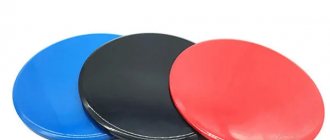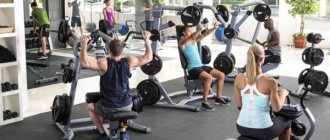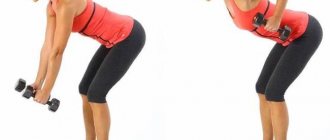Finally, you decided to go to the gym. If this is your first time, then it won’t hurt to learn a few rules that will help you understand what’s what and not feel stupid among the regulars.
In this article, we have collected everything you need to know before starting a gym session for beginners and those who have returned after a long break.
Gym for beginners
We will start with descriptions of gym visitors so that you understand who you will meet on your first day at the gym and spend 5-8 hours a week next to them. They can be divided into several groups.
- "Muscle squad"
This group includes those people who believe that nothing is more important than muscles. These are mostly men who like to “pull iron.” They are easy to spot among other gym visitors - throughout the workout they admire themselves in the mirror and give advice to those who have been in the gym not so long ago. Their main goal in life is to look like the Hulk, and they are successfully moving towards this.
- "Dead and Loafers"
It seems that someone forced these people into training - for example, husbands or wives - because they have stopped fitting into their own trousers or are unhappy with their appearance because their trousers are falling off. They prefer to take lighter weights - they simply cannot handle heavy ones, or even sit on the bench. Thus, they become a constant object of ridicule from the “muscle squad”.
- "Gossips and Gossips"
This category includes mostly women, but occasionally men are included. For them, the gym is another place where they can gossip and talk about other people. Usually they gather in small groups and evaluate the people working nearby, laughing periodically.
- "Pretentious fashionistas"
This category includes pretty and toned ladies who come to the gym to stay in shape. They seem designed to make other women in the room feel bad in comparison. They become the object of adoration of both the “muscle squad” and the coaches.
- "Groaners"
The last group includes seemingly unremarkable and generally good people. It is difficult to classify them into any of the described categories, but as soon as they start to swing, it immediately becomes clear that they belong to this group, even if you are far from the gym. During classes, they make very loud primal sounds, which often frighten other visitors.
Complex "fat"
One of the excuses mentioned above never gave me peace. More precisely, then it seemed to me that this was another excuse. It was mainly used by mature women, as well as girls who had never exercised before, when I invited them to visit a fitness club.
Most women experience exactly the same fears and emotions.
The phrase sounded something like this: “I won’t go to the gym. I’m fat (unathletic, thin, not flexible, fill in your choice) and I don’t know how to do anything, everyone will point the finger at me.” And, as it turned out, these words are not another excuse for one’s own laziness, but a psychological fear of many women.
The root of this fear lies in two phenomena:
- The first of these phenomena is a certain self-doubt, which to one degree or another is present in most people before discovering something new. This is a normal condition and will pass naturally.
- And the second is something that can and should be fought against. This is ignorance and misunderstanding of the atmosphere that reigns in a typical fitness club.
Where to start at the gym for the first time
Now that we have figured out the types of people you can meet in the gym, let's move on to more important information. So, what does a beginner need to know before going to training for the first time?
No need to try to lose 5 kg in one day!
A common mistake made by beginners is overloading the body during the first lesson. Add more load every day, but you don’t need to train for four hours straight on the first day. It took you a while to gain the weight, so be prepared to take some time to lose those extra pounds. If you ignore this advice, you can easily get injured.
Make a plan before you go to the gym
The day before your first workout, make an exercise plan, but it’s better to take it not from your head, but from proven sources. They usually offer exercises that are easy to do and safe.
To learn more about how to start training correctly, what a novice bodybuilder needs to pay special attention to, you can read in the articles training for a novice bodybuilder, part 1 and part 2.
Warm-up
Don't even think about starting strength training exercises without first warming up. Dynamic stretching is one of the best warm-up options, including circles with shoulders and arms, bends and lunges.
Be sure to do a 15-minute warm-up. During training, take lighter weights to establish the correct technique for performing the exercises. Start by doing two sets of 10 reps on leg presses, then do two sets of 10 reps on the stepper. After that, move on to the upper body - 30 biceps curls, 30 triceps curls. You can perform fewer repetitions, the main thing is to make sure that there is an even load on each arm. Then do 15 crunches, but don't go all the way down to the floor. Finish your workout with 10 minutes of cardio of your choice.
What do you need to take?
If you consider and compare the luggage of each person visiting the gym, you can find completely different things. Without some, it is simply impossible to do fitness, others may be needed from time to time, and some will simply lie in your bag all the time as a useless burden. The main thing is to focus on those items that everyone should have in their arsenal when visiting a fitness club. What do you need to prepare for training?
- a bag for things;
- clothing and footwear for sports activities;
- water;
- training diary;
- hair elastic;
- towel;
- shower accessories.
In addition to these things, you may need additional accessories, which will be discussed a little later. But the items from this list should definitely be with you in the gym.
Sports bag
The first thing you need to worry about is where to put the things you need for training. Sports bag or backpack – decide for yourself. For example, if you have to get to a fitness club by public transport, a backpack may be preferable. The main thing is that the product is comfortable, compact, but roomy enough, and made of durable, non-staining fabric. It is better to buy a sports bag with several compartments of different sizes, fastened with a zipper, where each accessory will have its own place so that you can easily find the right thing.
Cloth
The main criteria that a sports uniform must meet are convenience, safety and comfort. Some prefer modern “breathable” synthetics, while others remain faithful to classic cotton. A girl will feel comfortable in shorts, leggings that do not restrict movement, and a T-shirt that is loose enough, but not too roomy so as not to interfere with the exercise equipment in the gym.
In general, clothing should be the right size, have strong or double seams, be lightweight, and breathable. If synthetics are chosen, then only special, sports ones. In addition, pay attention to special sports underwear - bras, which are also on sale.
Shoes
When going to the gym, pay special attention to your shoes. The best option for training is light, comfortable sneakers. For jumping exercises and running on a treadmill, models with shock-absorbing inserts are suitable, which will reduce the load on the joints and provide proper support to the legs. It is advisable that the shoes be made of hygroscopic material to avoid the appearance of calluses and fungus, and with a springy sole of medium hardness.
Sneakers can only be used during weightlifting activities. And you should completely avoid flip-flops, flip-flops or ballet shoes: such shoes can cause injury during exercise.
Water
A bottle of water is one of the required items for working out in a fitness club. During training, you need to replenish your fluid supply to restore strength. There should be at least half a liter of still water in stock. If you are going to do cardio or strength exercises, the amount of fluid you drink increases. It is better to have a liter bottle of water with you. It is convenient to use a special container for cyclists, which is easy to use and liquid never spills from it.
Before you go to the gym, ask if there is a water cooler there - then you can count on it. Regarding the amount of water you can drink during training, consult with your trainer and focus on how you feel.
Training diary
One of the important accessories for sports training. This could be a gadget application or a regular notepad with notes. Thanks to it, each workout can be compared with the previous one, tracking progress and increasing the load when necessary. Recording achieved results is a good incentive to conquer new sports peaks.
Scrunchy
This accessory, which takes up virtually no space in your sports bag, will be very useful if you have long hair. You can use a headband instead of an elastic band. Loose hair gets in the way and irritates you during exercise, so it’s better to put it in a neat ponytail or put it under a bandage.
Towel
A must-have attribute not only for taking a shower after a workout, but also for wiping away the sweat that is released in large quantities during intense exercise. You can also place a towel on the exercise machine, which has wet marks left after the previous visitor.
Expensive fitness clubs usually provide towels. If such a service is not offered, take two or three with you: one large bath, the rest for hygiene during classes.
Shower accessories
Taking a shower after training is mandatory: basic hygiene, a way to tone yourself up and the ability to relax are very important. For water treatments in the gym, you need to take standard shower accessories with you: gel, shampoo, washcloth, comb. There is usually no need to take a hair dryer with you: every club should have such a device.
Be sure to take flip-flops with you to the shower: barefoot still has a chance of catching fungus even in a prestigious fitness club. Don't forget a couple of changes of underwear and socks: after a shower you want to put on everything fresh.
And one more important tip. You should not use strong perfumes - perfume, eau de toilette - before training: when mixed with sweat, they create a very unpleasant odor.
Exercises for beginners
This is a set of exercises that are perfect for the first day in the gym and not for the next 2-4 weeks, so that the muscles, ligaments and joints get used to the load. Only after completing this program can you move on to basic exercises with a barbell such as deadlifts, squats and bench presses, which are so popular with beginners.
Remember! When you first visit the gym or after a long break, you should not immediately do heavy basic exercises. There is a very high risk of injury. First, we get involved, get used to power loads on machines and with light weights, and only then move on to the base.
| Exercises | Sets x Reps |
| Hanging Leg Raise | 2x15 |
| Crunches | 2x15 |
| Oblique crunches | 2x15 |
| Bench chest press | 2-3x10 |
| Lying dumbbell flyes | 2x12 |
| Seated dumbbell press | 2-3x10 |
| Standing Dumbbell Flyes | 2x12 |
| Wide grip vertical row | 2-3x12 |
| Horizontal row in a block machine | 2x12 |
| Hyperextension | 2x15 |
| Seated leg extensions | 2x15 |
| Leg press | 2-3x10 |
| Lying leg curl | 2x12 |
| Standing Calf Raises (Standing Calf Raises) | 2x15 |
| Standing biceps curl | 2x10 |
| Triceps on the block down | 2x12 |
You can start working out in the gym using three complex exercises, namely the bench press, deadlift and back squats, only after preparing the body for new loads. By the way, read the article about mistakes in squats with a barbell on your shoulders.
Eat something simple before your workout
An hour before going to the gym, eat something simple (consisting of a few ingredients) and easily digestible - food that will not upset your stomach. Remember, this is your first day, so there is no need to worry about a clear time schedule for eating before and after the end of your workout.
Share your daily goal with your friends
The easiest and most proven way to stay motivated to work is to share your plans openly, for example, on Facebook. You won't want to lose face in front of your friends, which will help you stay motivated and disciplined.
Get help from a friend or coach
You probably know at least one person who, as they say, “ate the dog” while training in the gym.
Ask him to bring you up to date and help you figure out what's what. However, this approach has a significant drawback - such a person will most likely rush to share too much at once, which can overwhelm and confuse you. Moreover, even if your friend knows how to correctly and gradually present important information regarding training, there is a chance that you will feel like an opponent in him or, on the contrary, you will feel weak and inexperienced against his background. A better solution would be to seek the help of a trainer, which is available in every gym. He will give you a tour and show you where the locker rooms, showers and halls for group training are located, as well as exercise equipment and equipment. Moreover, he will be happy to tell you how this or that exercise machine works and what muscles it is aimed at working.
However, it is better not to use the services of a personal trainer on your first trip to the gym, as personal trainers often push beginners too hard so that they don’t feel like their money is being wasted. This, in turn, increases the likelihood of injury and is absolutely not suitable for the first lesson.
Don't be afraid to ask
If you see other people working out in the gym, don’t be afraid to come meet them and find out what they are doing and what muscles they are training. Most will not refuse help and will willingly share information.
What to take with you to training
- Workout clothes should be comfortable and light. A T-shirt and shorts work well.
- Buy a spacious sports bag.
- Comfortable shoes are sneakers or sneakers.
- It is absolutely necessary to bring a bottle of water - under proper exertion you will be very thirsty.
- Gloves will help keep your hands free from blisters when lifting heavy weights, and will also provide a better grip on equipment without slipping.
- Also take a towel - you will need it to wipe off sweat from your body after exercise.
- Take a lock for the cabinet in which your bag and personal belongings will be stored.
- Many people also listen to music while working out, so you can try it by bringing your iPod with you.
Try everything
The key word is “try.” Listen to your body and choose the right exercises for you. Each workout should include more than three exercises for each muscle group - fortunately, you have plenty to choose from. Perform each new exercise in two sets of 12-15 repetitions. If during the second approach it seems to you that you have no strength left, then move on to the next exercise.
Keep a diary
The numbers don't lie. Measure your progress, but in the right quantities. For example, you can get rid of fat and build muscle - this means that the weight will remain the same, but you will get in shape (accordingly, focusing only on weight is a bad idea). Write down all the exercises you do, as well as the number of sets and reps you perform.
Recover properly
Congratulations, you have survived your first gym workout! Now you need to properly recover - this means having a nutritious snack within 30 minutes after training, for example, drinking a chocolate milkshake. Protein is also needed for recovery, but try to avoid foods high in fat. In general, the day after training, eat only nutritious and healthy foods (and always!).
Training program for absolute beginners
If this is your first time in the gym, you should not start with complex and difficult exercises. Even if you have watched 100,500 training videos on YouTube and are confident that you are in amazing physical shape, forcing the load is an unreasonable risk.
Girls and boys, as a rule, have different training goals. Women want to lose weight, and men want to build muscle and become stronger. Therefore, their programs will be different.
Sample plan for men:
- Warm up (10-15 minutes). The ideal option is to exercise on a treadmill, exercise bike, or jumping rope.
- Leg press (3 sets of 15 reps).
- Leg curls (2x15).
- Pull-ups on the horizontal bar (3x5).
- Press on a machine for the pectoral muscles (3x15).
- Shoulder exercise (3x15).
- Dumbbell curls for biceps (3x10).
- Triceps block raise (3x10).
- Ab crunches (3×20).
This is a basic set of exercises for beginners in the gym. In the future, you or your coach will supplement it depending on the sensations and first results.
Program for girls:
- Warm-up (with stretching).
- Hanging leg raises (3 sets of 5-10 reps).
- Pull up - as much as possible.
- Leg bending from a lying position (3x15).
- Squats with a bar (2x10).
- Upper block row (shoulders) (2x15).
- Dumbbell bench press (3x15).
- Press crunches (3x15).
Rest time between sets is from 3 to 5 minutes. This is exactly what is needed to restore strength and reduce lactic acid levels.
A preliminary plan disciplines and makes the process more meaningful and effective.
Programs for beginners are designed in such a way that they work all muscle groups at once, loading them evenly. After 2-3 months, you can move on to split training, when the program is divided into parts, each of which is performed on different days. We will write about this in detail in our next articles.
First month in the gym
Now that you have a little experience, you can move on to more serious training. Strength training helps you achieve many goals - whether it's building muscle, burning fat, or increasing your overall performance. The selection of weights and exercises depends on the goal you are pursuing. Below are some general recommendations.
- If you want to build muscle mass, take heavier weights. Good weights and slow exercises are the key to building the body of your dreams. The optimal number of repetitions per approach is 4-8.
- If you want to lose weight, do more repetitions. In order to lose weight, you need to do more repetitions with light weights. The optimal number of repetitions per approach is 10-12.
- If you want to increase your overall performance, engage your whole body. Exercising specific muscle groups does not increase overall performance, so periodically perform exercises that involve the maximum number of muscles, such as push-ups.
- Don't forget about exercises for the core muscles. Exercises for the core muscles - the abs and lower back - are necessary in order to build a solid “foundation” for performing other exercises.
- Stick to a certain routine. Set your own routine and follow it - for example, five days of training alternating arms, back and shoulders, legs, chest and abs, then one day of aerobic exercise. It is important to get used to your program and not waste time in the gym thinking about which exercise to do next.
Core muscles
This information will give you a general idea of the main muscles of the human body that need to be trained:
- Biceps – trained with arm pull-ups and weighted arm curls
- The triceps are responsible for the bulk of the muscle mass in your arms, so if you only train your biceps, you're wasting your time.
- The pectoralis muscle is the chest, trained with bench presses and push-ups.
- Back muscles - include several muscle groups, which, along with the leg muscles, form the largest muscles of the human body
- Deltoid muscles - shoulder muscles
- Rectus and oblique abdominal muscles - trained by twisting, bending and exercises for the muscles of the center
- Gluteal muscles – trained by squats and lunges
- Quadriceps are thighs that should not be neglected, as they stimulate the production of chemical compounds necessary for building muscle mass.
- Hamstring muscles - trained by leg curls
- Calf muscles and forearm muscles - they are quite difficult, but need to be trained
“Beneficial” and “harmful” pain
It is important to be able to distinguish between “helpful” pain, which occurs in the muscles after strength training and lasts one or two days, from “harmful” pain, which lasts several days and may indicate an injury. If the latter is your case, then you should not postpone your visit to the doctor.
Strength training is usually safe, but if you don't exercise properly, you can damage something. This is why it is recommended to start with light weights to establish the correct technique.
Bruises, sprains, dislocations
They are the most common. Bruises are characterized by the appearance of swelling, bruising and pain at the site of injury. First aid:
- Ensure complete rest.
- Apply a pressure bandage.
- In case of hemorrhage, raise the damaged area above body level.
- Apply an ice pack.
A sprain is manifested by severe pain, the development of swelling and impaired movement in the joints. First aid is carried out according to the same algorithm as for bruises.
A dislocation is characterized by an unnatural position of the limb, a change in its length, lack of movement in the joint, and sharp and intense pain. First aid:
- Apply cold.
- Give painkillers.
- Immobilize the damaged area.
- Take him to a doctor.
Remember, only a specialist should correct a dislocation. Otherwise, the consequences of the injury may worsen.










